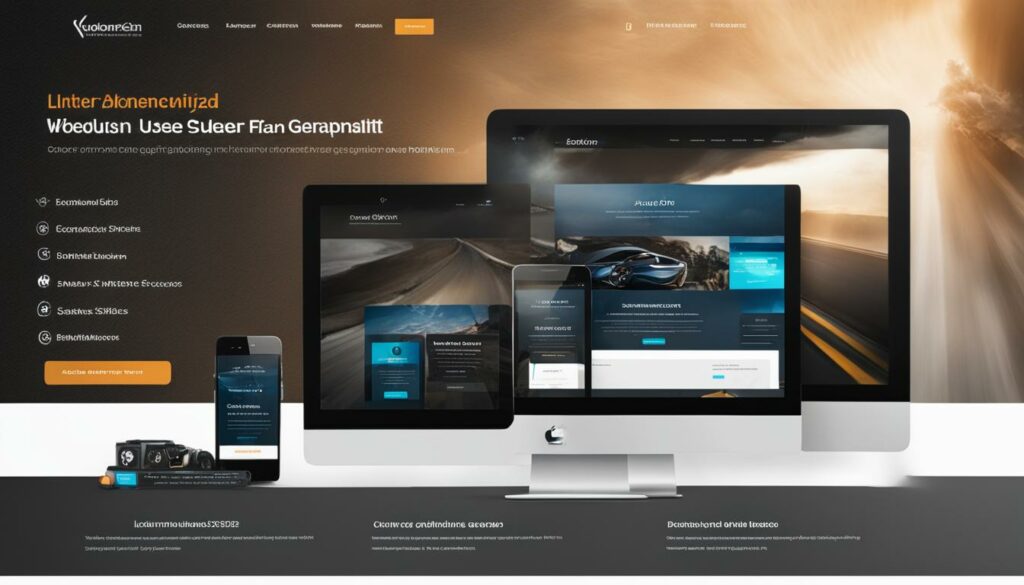Welcome to our comprehensive guide on WordPress speed optimization! If you’re looking to improve your WordPress website speed, optimize its performance, and increase loading speed, you’ve come to the right place. In this article, we’ll equip you with easy-peasy tips and tricks that will leave your visitors in awe of your lightning-fast site.
Before we dive into the nitty-gritty of speed optimization, let’s understand the importance of a fast-loading website. A slow site can deter users, increase bounce rates, and adversely affect conversions. On the other hand, a speedy website enhances user experience and even boosts your search engine rankings.
To get started on your speed optimization journey, it’s essential to optimize your hosting. We recommend WordPress Hosting from BoostedHost for optimal performance. Sign up now through this link.
Key Takeaways:
- Improving your WordPress website speed is crucial for better user experience.
- Optimizing your hosting provider is the first step in speed optimization.
- Assess your website’s current speed performance using tools like Google PageSpeed Insights and GTmetrix.
- Optimize your WordPress themes and plugins to reduce server resources and improve speed.
- Optimizing images, implementing caching strategies, and code minification can significantly boost your site’s speed.
Understanding the Importance of Website Speed
Before we dive into the ways to enhance your website’s speed optimization, let’s first acknowledge the significance of website speed. It plays a crucial role in providing an exceptional user experience and contributes to the overall success of your online presence.
A fast-loading website has several advantages that directly impact user engagement and conversions.
- User Experience: A slow website frustrates visitors and may lead to high bounce rates. On the other hand, a fast website keeps users engaged, allowing them to navigate effortlessly and access the desired information quickly.
- Reduced Bounce Rates: When your website loads quickly, visitors are more likely to stay longer and explore more pages. This lowers your bounce rate, indicating that users find your content relevant and engaging.
- Improved Conversions: Studies have shown that faster websites have better conversion rates. A slow-loading site can deter users from completing desired actions, such as making a purchase or filling out a form. On the contrary, a fast website ensures a smooth user journey, increasing the likelihood of conversions.
- Boosted Search Engine Rankings: Search engines, like Google, consider website speed as a ranking factor. Faster websites are more likely to rank higher in search engine results, leading to increased visibility and organic traffic.
Remember, a slow website not only affects user experience but also impacts your bottom line. By prioritizing website speed, you can create a positive impression on visitors, reduce bounce rates, improve conversions, and ultimately boost your search engine rankings. Your website’s speed optimization journey starts here.
Optimize Hosting for Speed
When it comes to speed optimization, choosing the right hosting provider is essential. Your hosting provider plays a significant role in ensuring that your website loads swiftly, keeping your visitors engaged and satisfied. Factors such as server response time, server reliability, and WordPress-specific speed optimization settings should be taken into consideration when selecting a hosting provider.
| Factors to Consider for Hosting Provider | Importance |
|---|---|
| Server Response Time | A fast server response time is crucial for a speedy website. It determines how quickly the server responds to a visitor’s request for your site. |
| Server Reliability | A reliable hosting provider ensures that your website is accessible and available to visitors at all times. |
| WordPress-Specific Speed Optimization Settings | Look for hosting providers that offer specialized settings for optimizing WordPress speed. These settings can help enhance the performance of your WordPress site. |
To optimize hosting for speed, we recommend WordPress Hosting from BoostedHost. BoostedHost offers reliable servers with lightning-fast response times and specialized WordPress speed optimization settings. With BoostedHost, you can create a high-performance website that delivers an exceptional user experience. Sign up now through this link: www.boostedhost.com/wordpress-hosting.

By choosing the right hosting provider and optimizing your hosting environment, you can significantly improve the speed and performance of your WordPress website. In the next section, we will explore how to assess your current website speed performance using various metrics and tools.
Accessing Current Website Speed
Before you start optimizing your website’s speed, it’s important to assess its current speed performance. This will give you a baseline understanding of how your website is performing and help identify areas for improvement.
There are several tools available to measure and analyze your website speed performance. Two popular options are Google PageSpeed Insights and GTmetrix. These tools provide performance metrics that can help you evaluate and optimize your website’s speed.
Evaluating Performance Metrics
When assessing your website’s speed, there are several key performance metrics to consider:
- Page Load Time: The time it takes for your web page to fully load and become interactive.
- First Contentful Paint (FCP): The time it takes for the browser to render the first piece of content on the screen.
- Mobile Performance: How well your website performs on mobile devices, which is crucial considering the increasing number of mobile users.
- Largest Painful Content (LCP): The time it takes for the largest content element on the screen to load.
- First Input Delay (FID): The time it takes for a user’s first interaction, such as clicking a button, to be processed by the browser.
- Cumulative Layout Shift (CLS): The amount of unexpected layout shifts that occur during the loading process, which can negatively impact user experience.
- Interaction to Next Paint (INP): The time it takes for the browser to respond to user interactions after the initial content has loaded.
- Time to First Byte (TTFB): The time it takes for the server to respond with the first byte of data when a user requests a web page.
By examining these metrics, you can gain valuable insights into your website’s speed and identify potential areas for optimization. This will help create a better user experience and boost your website’s performance.
To better understand how to interpret and analyze these performance metrics, let’s take a look at an example:

| Metric | Good | Needs Improvement |
|---|---|---|
| Page Load Time | >7 seconds | |
| First Contentful Paint (FCP) | >2 seconds | |
| Mobile Performance | Fast and responsive | Slow or unoptimized |
| Largest Painful Content (LCP) | >2.5 seconds | |
| First Input Delay (FID) | >100 milliseconds | |
| Cumulative Layout Shift (CLS) | >0.1 | |
| Interaction to Next Paint (INP) | >50 milliseconds | |
| Time to First Byte (TTFB) | >300 milliseconds |
This example table outlines what performance levels are considered good and where improvements may be necessary for each metric. Use this as a guideline to assess your own website’s speed performance.
Once you have identified the areas that need improvement, you can proceed to the next sections of this guide, where we will discuss various strategies and techniques to optimize your website’s speed and enhance its overall performance.
Optimize WordPress Themes and Plugins
Themes and plugins are an integral part of your WordPress website, but they can also contribute to slow loading times and consume server resources. To ensure optimal speed and performance, it’s essential to optimize your themes and plugins. Here are some key steps to follow:
1. Remove Unused Plugins
Unused plugins increase the load on your server and can negatively impact your site’s performance. Take the time to evaluate all installed plugins and deactivate or uninstall any that are unnecessary or no longer in use. By decluttering your plugin list, you can significantly reduce server resources and improve your site’s speed.
2. Choose High-Quality Plugins
When selecting plugins for your website, prioritize high-quality options that are regularly updated by their developers. These plugins not only provide better performance but are also more likely to be well-optimized and compatible with the latest WordPress versions. Check user reviews and ratings before installing a plugin to ensure its reliability.
3. Use a Lightweight Theme
Opt for a lightweight theme that offers only the necessary features and functionality for your website. A bloated and feature-rich theme can slow down your site’s loading times and consume excessive server resources. Look for minimalist themes that prioritize speed and performance without compromising on design or functionality.
4. Minimize Resource-intensive Features
Some themes and plugins come with resource-intensive features, such as sliders, carousels, or complex animations. While these features can enhance the visual appeal of your website, they can also significantly impact its speed. Consider disabling or minimizing these resource-heavy elements to optimize your site’s performance.
By optimizing your themes and plugins, you can reduce the load on your server and enhance your WordPress website’s speed and performance. Remember, a fast-loading site not only improves user experience but also boosts your search engine rankings. Take the time to assess your current themes and plugins and make the necessary optimizations to achieve optimum performance.

| Benefits of Theme and Plugin Optimization | Actions to Take |
|---|---|
| Improved site speed and performance | Remove unused plugins |
| Reduced server resource consumption | Choose high-quality plugins |
| Enhanced user experience | Use a lightweight theme |
| Better search engine rankings | Minimize resource-intensive features |
Optimize Images for Faster Load
Large images can significantly impact your site’s speed. To ensure faster load times and improved user experience, it’s essential to optimize your images. Here are some key strategies to follow:
Reduce Image File Sizes
Optimizing image file sizes is crucial for faster loading. You can reduce the file size without sacrificing image quality by using image compression techniques. Consider using online image compression tools or WordPress image optimization plugins to achieve efficient compression while maintaining visual appeal.
Implement Lazy Loading
Lazy loading is a technique that loads images only when they become visible on the user’s screen. By implementing lazy loading, you can prioritize the loading of important content and delay the loading of non-visible images. This can significantly improve your site’s speed, particularly for pages with multiple or large images.
| Image Optimization Strategy | Benefits |
|---|---|
| Reduce image file sizes | Improved loading speed without compromising quality. |
| Implement lazy loading | Enhanced user experience by prioritizing visible content. |
Did You Know?
Optimizing images for faster load times can boost your website’s performance, reduce bounce rates, and improve search engine rankings.
By optimizing your images through file size reduction and implementing lazy loading, you can significantly improve your site’s speed and enhance the overall user experience.
Sign up for WordPress Hosting from BoostedHost to optimize your website’s performance and ensure fast loading times.
Caching Strategies for Improved Performance
When it comes to speeding up your WordPress website, caching can work wonders. By utilizing caching strategies, you can significantly enhance your site’s performance and reduce load times. Let’s explore some effective caching techniques that will optimize your website’s speed.
1. Server-Side Caching
Server-side caching involves storing copies of files on the server and serving them to visitors without generating them from scratch. This technique reduces the load on the server and ensures faster delivery of content to your site’s users.
2. Browser Caching
Browser caching allows your website’s files to be stored locally on a visitor’s browser. This means that when a user visits your site again, the browser doesn’t have to retrieve all the files from scratch, resulting in faster load times. You can enable browser caching by adding cache control headers to your site’s HTTP response.
3. WordPress Caching Plugins
WordPress offers several caching plugins that help streamline your site’s performance. These plugins generate static HTML files of your web pages, which are then served to visitors instead of dynamically generating them. Popular WordPress caching plugins include WP Rocket and W3 Total Cache, which are user-friendly and provide settings for fine-tuning your caching strategy.
Remember, choosing the right caching strategy can have a significant impact on your site’s speed and overall user experience. Implementing server-side caching, browser caching, and using WordPress caching plugins will help reduce load times and optimize your site’s performance.
Make your website lightning-fast with effective caching strategies. #WordPressSpeedOptimization
As you can see from the image above, implementing caching strategies can greatly improve your site’s performance and reduce loading times. Take advantage of server-side caching, browser caching, and WordPress caching plugins to provide visitors with a seamless and speedy browsing experience.
| Caching Strategy | Benefits |
|---|---|
| Server-Side Caching | – Reduces load on the server – Faster content delivery |
| Browser Caching | – Speeds up page load times – Reduces bandwidth usage |
| WordPress Caching Plugins | – Generates static HTML files – Fine-tunes caching settings |
Code Optimization and Minification
When it comes to speeding up your website, optimizing and minifying your code is crucial. By reducing the sizes of CSS and JavaScript files and optimizing their delivery, you can significantly improve your site’s performance. Here are some techniques to help you optimize your code and achieve faster loading times:
- Reduce CSS and JavaScript file sizes by eliminating unnecessary code and spaces. This not only reduces the amount of data that needs to be loaded but also improves the readability of your code. Remember, every line of code counts!
- Optimize the delivery of CSS and JavaScript files by leveraging techniques like code splitting and asynchronous loading. This helps prioritize the rendering of critical resources and ensures a faster and smoother user experience.
- Consider using tools like minification plugins or manual code optimization techniques to automate the process. These tools remove unnecessary characters, such as comments and white spaces, and consolidate code, resulting in smaller file sizes and improved load times.
By optimizing and minifying your code, you not only reduce the file sizes of your CSS and JavaScript files but also make them more efficient for browsers to process. This translates to faster load times and an overall smoother browsing experience.
Optimizing your code is just one piece of the speed optimization puzzle. In the next section, we’ll explore the importance of regular WordPress updates and how they can further enhance your site’s performance.
Make Regular WordPress Updates
Regularly updating WordPress core, themes, and plugins is crucial for performance optimization. By keeping your WordPress website up to date, you can ensure improved site performance, enhanced security, bug fixes, and access to extended functionality.
WordPress releases updates regularly to address any vulnerabilities, improve compatibility, and add new features. These updates not only enhance the overall performance of your website but also protect it from potential security risks.
Updating the WordPress core is the foundation for a stable and secure website. It involves upgrading to the latest version of WordPress as soon as it becomes available. This ensures that your site is equipped with the latest features, improvements, and bug fixes.
Additionally, updating your WordPress themes and plugins is equally important. These updates often include performance optimizations, bug fixes, and new features. Keeping your themes and plugins up to date ensures that you are getting the best out of them and that they are compatible with the latest WordPress version.
To update WordPress, follow these simple steps:
- Before updating, back up your website to avoid any potential data loss.
- Go to your WordPress admin dashboard and navigate to the Updates section.
- Check for available updates for WordPress core, themes, and plugins.
- Select the updates you wish to install and click the “Update Now” button.
- Wait for the updates to be installed, and then test your website to ensure everything is functioning correctly.
Regularly updating WordPress core, themes, and plugins not only improves site performance but also ensures security, bug fixes, and enhanced functionality. Keep your site up to date to benefit from the latest advancements and to safeguard your website from potential vulnerabilities.
Conclusion
Speed optimization is vital for the success of your WordPress website. By implementing the tips and techniques discussed in this guide, you can boost your website’s performance and greatly improve the user experience. Faster site loading times lead to higher search engine rankings, decreased bounce rates, and increased conversions.
In summary, here are the key speed optimization tips you should focus on:
- Optimize your hosting by choosing a reliable provider with specialized WordPress speed optimization settings.
- Assess your current website speed using tools like Google PageSpeed Insights and GTmetrix.
- Optimize your WordPress themes and plugins by eliminating unused plugins and using a lightweight theme.
- Optimize your images by reducing their file sizes and implementing lazy loading.
- Implement caching strategies using server-side caching, browser caching, and caching plugins.
- Optimize your code by reducing CSS and JavaScript file sizes and optimizing their delivery.
- Regularly update WordPress core, themes, and plugins to ensure improved performance and security.
Remember, a fast-loading website not only improves user experience but also boosts your website’s performance and enhances its overall efficiency. For optimal performance, we recommend WordPress Hosting from BoostedHost. Sign up now through this link: www.boostedhost.com/wordpress-hosting.
FAQ
Q: What is the importance of website speed?
A: Website speed is crucial because it enhances user experience, reduces bounce rates, improves conversions, and boosts search engine rankings.
Q: How can I optimize hosting for speed?
A: To optimize hosting for speed, consider factors like server response time, server reliability, and specialized WordPress speed optimization settings when choosing a hosting provider.
Q: How can I assess my website’s current speed performance?
A: You can use tools like Google PageSpeed Insights and GTmetrix to evaluate metrics such as page load time, First Contentful Paint (FCP), mobile performance, Largest Painful Content (LCP), First Input Delay (FID), Cumulative Layout Shift (CLS), Interaction to Next Paint (INP), and Time to First Byte (TTFB).
Q: How can I optimize WordPress themes and plugins?
A: Optimize themes and plugins by removing unused ones, choosing high-quality plugins with regular updates, and using lightweight themes with only necessary features.
Q: What should I do to optimize images for faster load times?
A: Optimize images by reducing file sizes without sacrificing quality with image compression tools or WordPress image optimization plugins. Consider implementing lazy loading for images, loading them only when visible on the user’s screen.
Q: What caching strategies can I use to improve performance?
A: Consider server-side caching, browser caching, and utilize WordPress caching plugins like WP Rocket or W3 Total Cache to store copies of files and serve them more efficiently.
Q: How can I optimize code for better speed?
A: Optimize your website’s code by reducing the sizes of CSS and JavaScript files, eliminating unnecessary code and spaces. Optimize the delivery of CSS and JS files to enhance performance using minification plugins or manual code optimization techniques.
Q: Why is it important to make regular WordPress updates?
A: Regularly updating WordPress core, themes, and plugins is crucial for improved performance, extended functionality, enhanced security, bug fixes, and preventing vulnerabilities.
Q: How can I boost my WordPress website’s performance?
A: By implementing the tips and techniques discussed in this guide, you can optimize your website’s speed, improve user experience, and boost your website’s performance overall.












